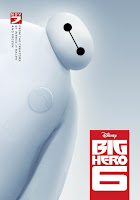The weekend of November 7-9, 2014, was arguably one of the best weekends for movies in quite a long while. Both major films released that weekend were anticipated science-fiction/action-adventures--one, a live-action ambitious epic from director Christopher Nolan; the other, a CGI ride from Disney Animation.
A friend of mine insisted on not reading or watching anything about the former (well, mostly anything) before seeing it. And Nolan has been notorious for keeping his film projects under wraps--at least until they're finished and/or are close to their release dates. At the same time, it allows audiences to anticipate the kind of story and adventure they’ll discover on the big screen.
"To Boldly Go . . ."
There are arguably four kinds of people represented in Interstellar: farmers, pilots, engineers, and explorers. While the former is represented during scenes on earth, the latter three represent an evocative sense of exploration and the aforementioned discovery. The film’s teaser trailer, as follows, conveys this very well.It certainly is a different kind of film than anything the director has done. Memento was a detective story in reverse, while the Dark Knight trilogy gave a DC Comics character new life, grounded in reality; and Inception took place in the labyrinth minds of its deceptive characters. But while all of these films often contain cerebral, cold, and bleak elements, Interstellar tackles science-fiction and physics, as well as space-travel for the sake of a dying earth. This concept of discovering new worlds via a wormhole in the cosmos and searching for a hope for mankind is secular and humanistic as far as the film’s worldview is concerned. On the other hand, it does leave audiences with much to discuss and debate in terms of not only scientific perspectives, but spiritual as well. In fact, the slogan on the film's teaser poster states, "Mankind was born on earth. It was never meant to die here."
In addition, it’s suggested that it’s not technology that's the enemy (like HAL 9000 in 2001: A Space Odyssey), but time itself. In other words, what may seem like an hour on one planet is twenty years on another.
 |
| At it's heart, Interstellar is a father-daughter story. |
Perhaps McConaghey's Cooper not only echoes the everyman we can identify with, but also Nolan's role as a filmmaker, discovering new things, new places, and new possibilities for audiences to explore, to experience, to discuss, and to debate.
Indeed, Nolan breaks new ground with an out-of-this-world story. And the technology and tools he uses (from IMAX cameras to real locations and practical effects, and a mesmerizing score by Hans Zimmer) give us a whole new experience.
Disney Animation, on the other hand, explores a different kind of territory with an obscure Marvel comic book series about a group of science kids (and an inflatable robot) who inadvertently become superheroes. And while these kids aren’t out to leave earth and find new planets through wormholes, they do become heroes for each other and for their world.
Set in the fictional San Fransokyo (a creative mending of San Franciscan and Japanese architecture), Hiro Hamada is a high-school kid and robotics prodigy who sees nothing better in life than battle-bot competitions and hustling. His older brother Tadashi challenges and encourages him to put his scientific and creative skills to good use by applying to the local tech college. The characters we meet there include the cautious though slightly neurotic Wasabi, tough-as-nails Gogo, chemistry enthusiast Honey Lemon, the mascot-dressed Fred, and the endearing plush robot Baymax.
 |
| Clockwise from top: Tadashi, Wasabi, Honey Lemon, Hiro, GoGo, and Fred |








First off, you reminded me that I still need to see Big Hero 6, so thank you for that. Your well-blended synopsis and analysis of the film sold a ticket (so to speak), and I always need something to watch. Interstellar managed to overshadow the release of BH6 at the time for me. It's unfortunate that I allowed what sounds to be another great film from the team at Disney Animation Studios to get lost in the shuffle.
ReplyDeleteAs for Interstellar, it's a sign of a great film when I can't seem to rid it from my thoughts. I've revisited the movie a few times in 2015, always making a new discovery of my own upon each viewing. I suppose by giving us so much to discuss Nolan has made us all explorers in a way.
I enjoyed how Nolan played with science-fiction conventions too — like in the case of Tars and, well, Case. Funny how the role-reversal of technology almost felt like an ode to Kubrick, reminiscent of AUTO in Wall-E.
It's probably because 2001 is such a seminal work in the genre, but I can't stop comparing Interstellar with Kubrick's masterpiece. Even that bleak, cerebral tone evokes 2001. However, Nolan does try to pull at the heartstrings too. I agree that the movie still felt cold, but that seemed unintentional almost given the emphasis on Coop and Murph's relationship. I think Nolan wanted Interstellar to feel closer to films like Solaris and The Fountain, but his sensibilities as a director are perhaps too close to Kubrick's to deliver that emotional punch to the gut (at least for me). Regardless, even if it didn't crescendo for this viewer like I was hoping, it's an interesting, ambitious, and intelligent ride that I continue to engage with.
Anyway, loved your article. You clearly provoked a discussion with this reader about one of my favorite films of 2014, and maybe helped me discover another. Well done.